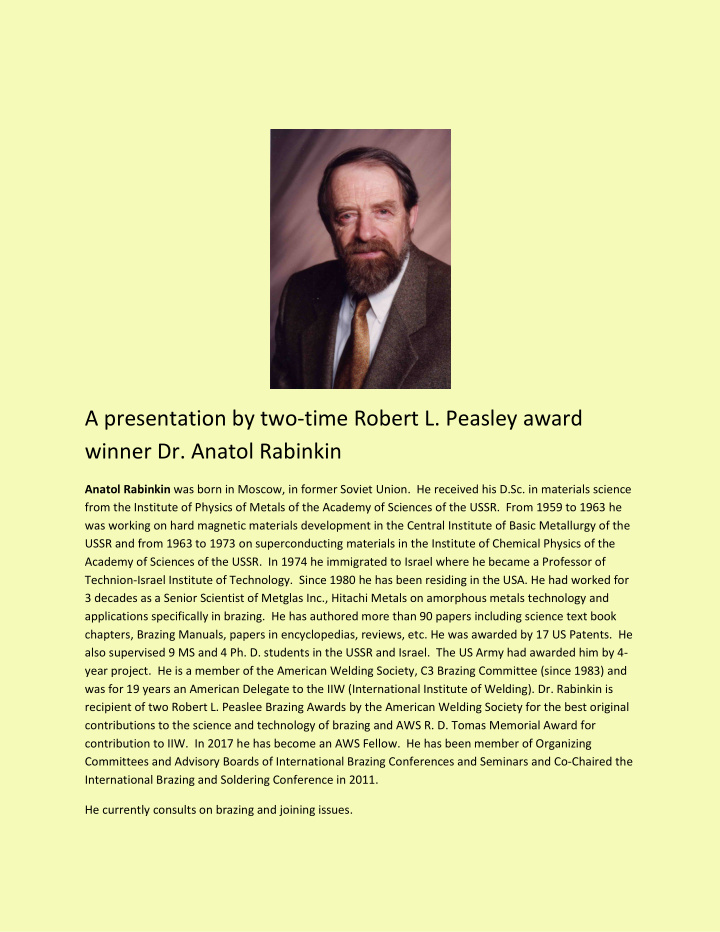



A presentation by two-time Robert L. Peasley award winner Dr. Anatol Rabinkin Anatol Rabinkin was born in Moscow, in former Soviet Union. He received his D.Sc. in materials science from the Institute of Physics of Metals of the Academy of Sciences of the USSR. From 1959 to 1963 he was working on hard magnetic materials development in the Central Institute of Basic Metallurgy of the USSR and from 1963 to 1973 on superconducting materials in the Institute of Chemical Physics of the Academy of Sciences of the USSR. In 1974 he immigrated to Israel where he became a Professor of Technion-Israel Institute of Technology. Since 1980 he has been residing in the USA. He had worked for 3 decades as a Senior Scientist of Metglas Inc., Hitachi Metals on amorphous metals technology and applications specifically in brazing. He has authored more than 90 papers including science text book chapters, Brazing Manuals, papers in encyclopedias, reviews, etc. He was awarded by 17 US Patents. He also supervised 9 MS and 4 Ph. D. students in the USSR and Israel. The US Army had awarded him by 4- year project. He is a member of the American Welding Society, C3 Brazing Committee (since 1983) and was for 19 years an American Delegate to the IIW (International Institute of Welding). Dr. Rabinkin is recipient of two Robert L. Peaslee Brazing Awards by the American Welding Society for the best original contributions to the science and technology of brazing and AWS R. D. Tomas Memorial Award for contribution to IIW. In 2017 he has become an AWS Fellow. He has been member of Organizing Committees and Advisory Boards of International Brazing Conferences and Seminars and Co-Chaired the International Brazing and Soldering Conference in 2011. He currently consults on brazing and joining issues.
Gold and Arising of Metal Joining • Neolithic Revolution-Explosive growth of civilization after the end of the last Ice Age 10-12 millennia ago: Animal domestication, agriculture initiation, Excessive food production and its accumulation and conservation; appearance of people settlements in 10-9 millennia BC. • Human skill specialization; products, goods, and human experience and genetic pools exchanges; trade initiation. • Discoveries of advantageous properties of native metals such as ability to change their form and physical properties found first in meteoritic iron, then gold (6000 BC) and afterward copper (4200 BC) and beginning of their usage. • Separation of copper and gold applications-Former for mostly warfare and later for adornments. Realization of usefulness of alloying of various metals and its conscious usage. • Beginning of metal joining in Thrace (now Bulgaria) 4600-4500 BC and Mesopotamia, 3000-2500 BC. • Discovery of hard soldering or diffusion bonding and colloidal soldering used in joining of cast or mechanically made parts. • Unearthing of brazing filler metals and solders as low melting alloys providing joining of metal parts. First fluxes/brazing filler metals for gold joining made of natural copper compounds such as Malachite (CuCO3 ·Cu(OH)2), Cuprite (Cu2O), etc. • Invention of high temperature, up to 1200-1500°C, sources and ovens using high volume air supply to wooden coal as the fuel source. • Granulation and filigree processes. • Establishing of first specialized metal smiths shops in Ancient Egypt equipped with melting, brazing and heat treating furnaces/kilns. • First mentioning in History of names of real goldsmiths, -Bezalel and Oholiab,-in Israel, ca 900 BC, First Temple builders (Bible, 1 Kings 1–11,). • Spreading of gold/metal joining around the Globe, sometimes originating independently and without outside knowledge sources (Mesoamerica, etc.). • The pictures will be shown of some incredibly beautiful and highly sophisticated Ancient gold brazed artifacts made in different countries located in various continents. Some results of modern analytical means applied to these objects will be given revealing how these brazements were made. • In conclusion, 5-7 min- long movie made in the NY Metropolitan Museum of Art will be presented showing the real reproduction of ancient gold granulation brazing processing.
Please email or call Tom Ferri @ 508-789-2040 or taferri@comcast.net we need a head count for ordering pizza. Parking is in the back of school by first large overhead door with steel pipes on the ground to the right of door.
Recommend
More recommend